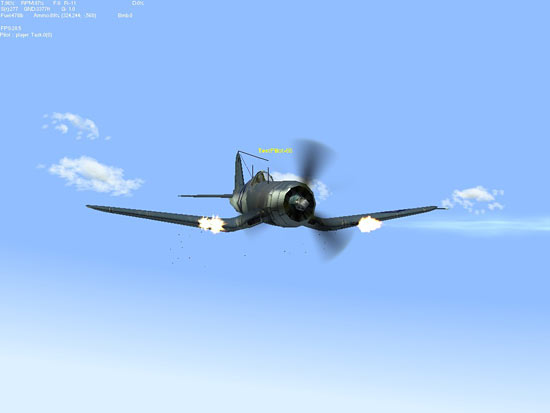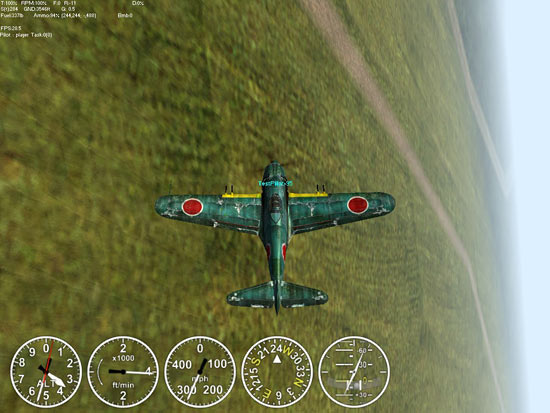|
Interview
October 22, 2001
Discussion Of Boom And Zoom Tactics
by Andy Bush
Lesson One (October
22/01): Defending Against The Boom and Zoom
You are presented with the
following situation: a typical "angles" fighter, such as
a Spitfire, is bounced by a typical "energy" fighter, such as
the P-38. The attacker has the altitude advantage and is using a
boom and zoom attack on you. What should you do?
 Response by David “Rapier” Pierot, representing Fighter Ace: Response by David “Rapier” Pierot, representing Fighter Ace:
First, if you find yourself in this position, shame on you! ;) Probably the major and most overlooked component of ACM is the part that happens BEFORE you engage. A key characteristic of successful real and virtual combat pilots is their ability to manage the situation leading up to an engagement and even declining to engage if the situation is not favorable. If you wouldn’t walk into a gunfight armed with a penknife, why enter a combat with a fatal disadvantage? You should select an aircraft and an altitude entering the combat area that allows you to control whether the engagement happens or not. It is an acceptable alternative to death (virtual or otherwise), to retreat and come back when you have succeeded in gaining an advantage in numbers, speed or altitude.
Admittedly there will be times when you will find yourself low and slow, particularly when engaging in a game like Fighter Ace’s anti-tank or anti-shipping missions, but you should try to mitigate these situations as much as possible (need I say "top cover"?)

Know your enemy(‘s aircraft) and relative altitude
If by poor judgment or circumstance you find yourself in this unenviable position, your long term health prospects are going to depend heavily on denying the opponent shot opportunities while encouraging them to blow their energy advantage by turning hard and long. To this end its important to know as much as you possibly can about the situation. Very quickly you must answer as many of these questions as you can:
-
What aircraft is my opponent flying?
-
What are the performance advantages that I have?
-
What are the performance disadvantages I have?
-
What is the relative altitude differential?
-
Am I affected by damage and how?
-
Is the opponent affected by damage and how?
-
Are there friends or enemies in the area?
-
Are there friendly or enemy AAA emplacements in the area?
Survival and victory will depend on playing the advantages in your hand against the opponent’s disadvantages. If the enemy pilot really knows their stuff and they are patient and there is no interference from outside sources, you can be in a world of hurt. Where is the enemy aircraft weak? Does it lose energy readily? Because of the cockpit layout, does the enemy pilot have blind spots? Does the enemy a/c have an altitude "sweet spot" in which it performs better? Does it have an altitude it performs poorly at? Can you maneuver the enemy into those situations and survive?
Keep them in sight
If you can’t keep the enemy in sight, all bets for a successful conclusion to the fight are off. Success in this scenario is entirely dependent on timing your maneuvers to the relative position of the enemy. Know your game’s view system inside and out. Fighter Ace offers both padlock and traditional 360 degrees above the wings view system. The best pilots can use the features of both to keep their enemy in sight throughout the fight.
What the enemy’s game is
While your opponent has the advantages, it’s not all a bed of roses on their end either. The B and Z pilot needs speed to pull up and out of your gun range (particularly with propeller driven a/c) but speed limits their ability to maneuver hard and follow a slower target. When an aircraft is above corner speed (best speed for maximum turn rate), generally the faster they go the more their ability to turn decreases. The enemy pilot must successfully manage their speed while diving, while gravity is encouraging their aircraft to increase speed rapidly. Our job is to make their speed management problem even more difficult. If we can whittle away or encourage them to blow their energy advantage, then our turn rate advantage can be brought into maximum effect.
Get under them
One way we do this is to encourage them to dive more vertically. An aircraft diving vertically will pick up speed much more rapidly than an aircraft in a shallow dive. One way to do this is to watch for the enemy pilot to start downstairs. We gauge this by the aircraft’s attitude and we utilize any range information we have. When we see this we turn into their aircraft and head to a point directly below their aircraft. This does two things for us. It shortens their shot opportunity (we are increasing the closure rate) AND it increases their speed by encouraging them to dive more and more vertically. Additionally pushing over in flight unloads the aircraft and increases acceleration. Ideally we can force them to go inverted in their attempt to follow us.
Now if the opponent has been fairly competent, they WILL have a shot opportunity once they are in guns range. We just don’t want any of those nasty ol’ shells to hit our plane. Your job is to make that shot opportunity as difficult or even impossible as you can. The way to do this is to give them an easy firing solution . . . right up to the point just before they pull the trigger. The idea here is to get the enemy to commit to a flight path by appearing to commit to yours. Keep your flight path steady and your speed at just above corner speed. Just before the opponent comes into range you want to pull a maximum gee turn in the direction that forces them to turn the hardest. Depending on the realism level of your sim (the advanced level of Fighter Ace has realistic physics that permit this) you can force the enemy into the pre-stall buffet, which will cause them to lose energy rapidly.
If you have timed all of this properly you will cause the enemy to miss or at least minimally damage your plane. Repeat as necessary. Just keep in mind that your opponent may be learning during the fight and may change their approach. One of the things that can be fatal to you is if they throttle back during the dive to slow their a/c and increase their turn rate in anticipation of your break. If they can put together a sufficiently long tracking shot, it could ruin your entire flight.
Another option, if your a/c has more firepower than theirs, and you have a lot of confidence in your gunnery, is to go for a head on shot. However its important to recognize that there are inherent risks in allowing the enemy ANY kind of shot opportunity. One of those rounds could be a golden BB with your name on it.

Risky but worth a try?
So far we have been discussing the safest, least risky strategies. There are a few other moves you can consider, but all involved a high degree of risk. Basically you are betting you can sucker the opponent into making a serious mistake. I’ll outline one and you can see what variations you can invent.
If you feel that you opponent is less experienced or very kill hungry AND you have sufficient altitude, you can wait for them to come down into their attack. Just before they hit gun range, roll inverted and pull into a split S. It’s helpful in this move to not pull it into a picture perfect, vertical split S but to have some horizontal movement in it as well so that it is a downward turning slice, which makes for an even more difficult firing solution. It’s also helpful to throw in a little uncoordinated control movement (rudder and compensate with a little opposite stick) so that your nose points slightly off of your real flight path. This makes it harder for them to correctly anticipate what chunk of space to aim for ahead of your airplane.
If they are over eager and attempt to follow the move, they will increase their speed even more and overshoot. This will give you an opportunity to even out the advantages and re-enter the fight with a more co-equal E state.
Conclusion
This set up is one of the least desirable from the standpoint of the "angles" fighter and it’s the one that the "energy" or B and Z fighter is most familiar with, as this is their bread and butter for kills in combat. As such, you need to be willing to utilize ANY of the advantages you can get. If you are able to drag the enemy towards friendly fighters or friendly AAA this can significantly change the odds, even if the friendlies are at the same altitude or lower than you are. One, it decreases your share of bullets and two; it increases the probability that the enemy will make a serious mistake.
Additionally, any hits you can get on the enemy can significantly increase your chances depending on the sophistication of the damage modeling in your sim of choice. In Fighter Ace you have the capability of damaging or disabling control surfaces, the engines and guns of the enemy fighter, any of which can reverse the situation.
Of course doing so and reversing the situation will make the enemy curse your name. But that is one of the unique rewards of air combat gaming.
Life is good.
--)-Rapier--- out.
View responses to the same
ACM situation from representatives of the following sims:
Click
here to go to top of this page.
|



